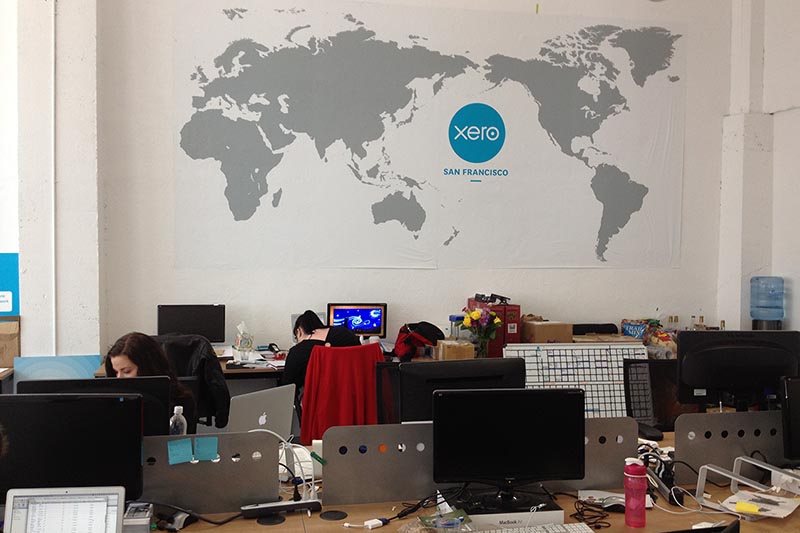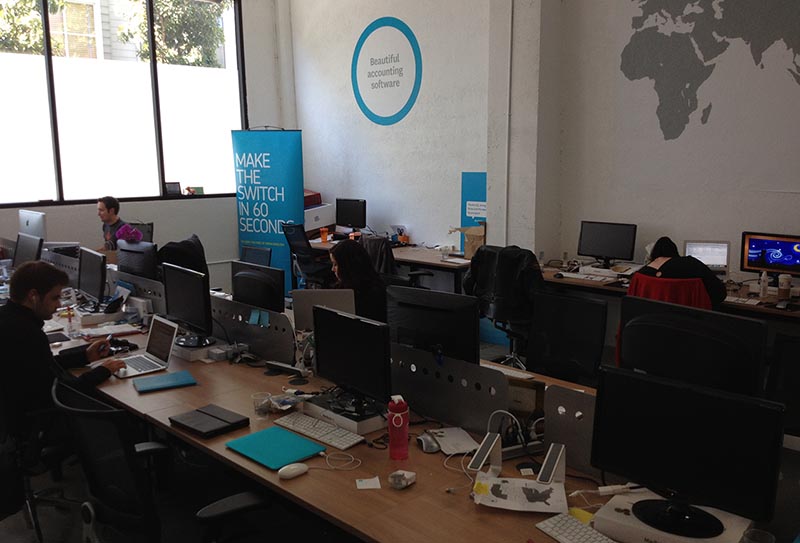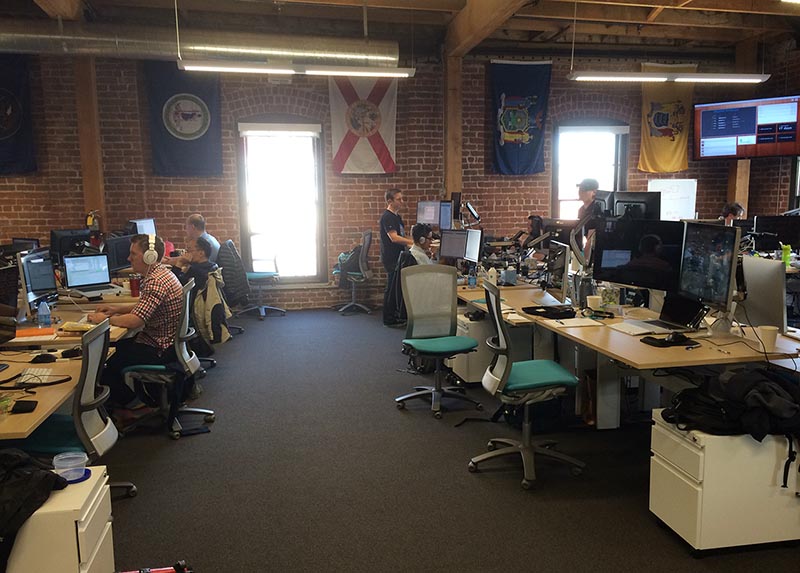Behind the scenes at Xero's US beachhead
Photos | A switch in marketing strategy | Obligatory smack talk about rival.
Photos | A switch in marketing strategy | Obligatory smack talk about rival.
This week I swung by Xero's new head office in the US, where much of the company's surge in new spending is happening (in its interim result, which saw losses more than double to to $17.1 million in the half-year to September, Xero said its US operating costs* increased by $5.9 million to $8.6 million).
But before I get to that, let's go back, back in time, to the mists of 2012 when Xero was worth a mere half billion ...
Around this time last year I swung by Xero's San Francisco office - a.k.a. a couple of benches in one corner of the Kiwi Landing Pad co-work space.
There was enough space for a dozen or so staff; four were there when I dropped by.
I captured the snug office in two snaps:


The Kiwi Landing Pad made it fast, simple and easy for Xero to set up in the US, president Jamie Sutherland says.
But in February this year, as staff numbers hit 30, it was time for Xero to find it own space.
The company relocated from the Landing Pad in SoMa (South of Market St - a trendy, transitional area with some hot tech companies, including LinkedIn and Twitter, but also some rough edges) to Jackson Street on the northern fringe of the Financial District. It's a grown-up neighbourhood, full of investment bankers and venture capitalists who feed off nearby Silicon Valley.
Early October, Xero outgrew Jackson St and moved a couple of blocks north to Green Street, which is where NBR dropped by this week.
ABOVE: the building; BELOW: The entrance and mezzanine floor.
Xero has 25,000 square feet over three levels in its new building, which Mr Sutherland says its its first long-term lease in the city.
Today it houses 75 of Xero's 110 US staff.
The others are in satellite offices spread around the country. “In Denver we just built a customer support centre. We’ve got some IT Ops people there. In New York we’ve got a small development shop, and in Los Angeles a sales team," Sutherland says.
There are a couple of Kiwis doing tours of duty in the US, but the vast majority of the staff are locals.
Xero has just over 600 staff worldwide, most across its two Auckland and two Wellington offices.
There are rows and rows of empty seats in the new office. Sutherland says the plan is to house 190 staff in building. He won't give a hiring timeframe.
Earlier this week, CEO Rod Drury told NBR that Xero will double its worldwide staff numbers to 1200 over the next 18 to 24 months.
The US would be one point of focus for the recruitment drive, Drury said. The company had just raised $180 million (taking total cash to $230 million). Investors didn't want Xero to keep the money in the bank, the CEO said. They wanted it spent on developing new products and winning new business.
ABOVE: Sutherland with members of the Xero's US payroll team. The Xero president says with different laws and regulations, with each state it's like developing a payroll system for another country. A state flag goes on the wall as payroll for each state is completed.
Like many local techs, Xero focuses product development in NZ, with offshore staff mainly sales-focused.
However, 25 staff in the San Francisco are dedicated to the key area of payroll.
Earlier, Drury told NBR that Xero's lack of payroll functionality meant it was "fighting with one hand behind its back" in the US market - and analysts say Xero must do well in North America to justify its heady $4.5 billion market cap.
The first payroll features will go live in December, Sutherland says.
“This is the payroll team here. We close them off with the plants to keep the quiet,” Sutherland says as NBR approaches the team working on the key project, indicating a couple of token pot plants. His low-key, droll humour is closer to Kiwi sensibilities than American (Sutherland is Canadian. He came to Xero in December 2011 from rival Sage Software, where he was VP and GM for North America, working out of an office Vancouver).
ABOVE: A behind-the-scenes glimpse at some of the high-tech, interactive technology used to plan Mr Sutherland and team's recent US roadtrip.
Xero has so far followed a similar tack in the US to other markets, working social media, the press, accountants and other influencers; staging its own events, and schmoozing around others.
In Australia it recently kicked off its first ever round of "traditional" marketing.
"It's like radio, bus stop signs, print – more traditional things you wouldn’t expect from an online company," Sutherland says.
He sees the brand campaign as a way to reach small businesses who aren't being swayed by their accountant, and says the offline approach makes sense on a meat-and-potatoes level. "We know a lot of small businesses spend time listening to the radio whether they're a restaurant or they have their own office or they're in retail. At retail they often play it all day."

ABOVE & BELOW: At the risk of this beginning to look like a real estate brochure with the owner in every shot, here's Sutherland on the roof of Xero's new building. There are views south to the Financial District, marked by the Transamerica Pyramid, and north to the stretch of San Francisco Bay where the America's Cup was raced.

Will the traditional marketing approach in Australia be followed in other markets?
"It's a good test for us. If it's successful there - and it's looking really good - then we'll consider it for other markets. But our regimen around this is that it gives the goals we want to achieve. Some of it is around aided and unaided awareness; the second piece would be converting companies," Sutherland says. Xero is comparing uplift in areas where it's running the campaign to areas where it's not.
It's possible, Sutherland says; the company is still assessing the impact of the Aussie campaign.
On the traditional marketing front, it was interesting to see Intuit running TV ads for its QuickBooks products, with payroll one of the highlighted features. Although Xero has a new-found taste for traditional media, its financial resources are modest relative to those of Intuit, which made $US858 million on $US4.12 billion revenue in its 2013 financial year. It has a $US20 billion market cap, 8000 staff and just over $US1 billion in the bank [UPDATE: Friday NZ time, Intuit reported its first quarter FY 2014 result. For the three months to October 31, it made a net loss of $US11 million on revenue that increased 11% to $US622 million. In the year-ago quarter Intuit had a $US19 net loss.]
ABOVE: Xero's SF office is hardly teeming with staff. In part that's because half the desks are set up for staff yet to be hired. But it's also because others are out sellng, or networking. This week, for example, Sutherland was in and out of Salesforce's giant Dreamforce conference.
There's been a rise in MYOB smack talk about Xero recently (admittedly with Xero giving its Aussie-based competitor plenty of space to land a punch as it proposed a price hike for some Australian users, then climbed down after a backlash).
“In the US market we’ve seen Intuit doing the same things," Sutherland says.
"They hosted an event over the top of XeroCon after we announced the dates of that, which might have been coincidental,” he says in a dry tone that indicates where he stands on that question.
(XeroCon San Francisco, staged during October to capitalise on the America's Cup, was the company's first major event for partners and accountants in the US.)
"And we see them doing more roadshow stuff that they haven’t done for some time. That’s what we’ve been doing; getting in front of accountants and showing them what’s going on," he adds.
"Then the whole redesign of their interface … We’ve talked to other vendors and they feel they’ve pulled best practices of what’s already on the market.
"It seems like we’re leading the charge and these guys are starting to catch up. But we know it’s hard to develop from a platform that was built over a decade ago and making that more conducive to web apps is not an easy endeavour. It’s about us introducing product faster and changing the product categories," he says.

"The stuff we’re introducing is stuff this industry hasn’t seen like Xero Files – drag and drop documents associated with transactions. Talking to customers, it seems very obvious for customers to have that, but know one else is doing document storage."
He reels off other features, Xero has but Intuit lacks – “things like multi-currency, expense claims and even the way we allow for unlimited users and they cap at five” (although it’s fair to say Xero is making a virtue of necessity with the latter; one suspects it would like to eventually be in a market position where it doesn’t have to offer companies unlimited users under a single subscrption).
Intuit is doing payroll. As mentioned above, Xero is going to start filling that feature gap in its US product from next month.
Meantime, Sutherland takes a jab at his rival's payroll feature, whom he notes has a payroll product by dint of its 2009 acquisition of PayCycle, which became Intuit Online Payroll, “But we hear the whole web services integration is not as seamless as it could be.” (Earlier, Drury offered the blunter verdict that QuickBooks Online was “very weak” in that area, and others.)
Sutherland and Drury are not neutral observers, of course, but the CEO also touts that Facebook/PayPal billionaire Peter Thiel recently upped his investment, again, after analysing Intuit's latest moves. And Xero has been getting good notices in the trade press, plus postive coverage from the likes of Fortune magazine and Bloomberg TV.
It needs it. There's a hill to climb. Intuit’s QuickBooks has a near-monopoly on the 29 million or so small businesses in the US – at least of those that use accounting software rather than Excel, an offline spreadsheet, or simply shovel a box of receipts in their accountant's direction. Intuit's latest SEC filing says it has 4.9 million small business customers worldwide (in Q2 FY2012 it had 5.1 million) - so it seems many in the wider small business community are ripe for the picking.**

ABOVE: Sutherland on Bloomberg TV. The Xero exec's rising media profile is good for the company per se, and reduces what sharemarket analysts call "key man risk" (as in, what could happen to Xero's share price if you-know-who gets hit by a bus).
But in the cloud area, things are a lot more finely poised.
In its full-year result for the year to July 31, released August 21, Intuit said users of its cloud product, QuickBooks Online, increased 28% during its 2013 fourth quarter to 487,000 [UPDATE: On Friday NZT Inuit released results for the the three months to to October 31, 2013 - the first quarter of its 2014 financial year. QuickBooks Online subscribers increased 5.96% to 516,000 duriing the quarter].
Xero is not a million miles from that total. On October 4, it reported an 89% annual gain in paying customers to 211,300 ("paying" is the operative word here; Xero has a standing challenge to Intuit to break out revenue numbers for QuickBooks Online).
The flipside is that Intuit is strong on its home turf; Xero has fewer than 20,000 of its customers inside the US, while Intuit has only 37,000 of its QuickBooks subscribers outside the US. As it adds bodies, and the addition of payroll lets it fight with both fists, Xero will be hoping to improve that ratio.
* Actually its US and rest-of-world operating costs, but with figures for Xero's major markets of NZ, Australia and the UK reported separately, and no major drive elsewhere, it's essentially a US figure.
** Intuit's most impressive stats are for its tax software. For its 2013 full financial year, it reported 26.2 million users of its US TurboTax product (19.3 million web, 5.8 million desktop and 1.1 millon through a freebie electronic filing option). It also reported 1.9 millon Canadian TurboTax customers for the quarter.
Sign up to get the latest stories and insights delivered to your inbox – free, every day.